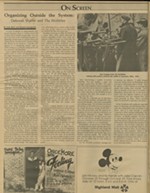Hi-De-Ho and The Duke Is Tops
Available on video as a double bill, these two all-black features -- one from 1938, the other from 1947 -- make a brilliant pairing.
Reviewed by Louis Black, Fri., April 27, 2001

HI-DE-HO
D: Josh Binney (1947); with Cab Calloway, Ida James, Jeni Le Gon, William Campbell, Virginia Girvin, George Wiltshire, Dusty Fletcher, Peter Sisters.
THE DUKE IS TOPS
D: William L. Nolte (1938); with Ralph Cooper, Lena Horne, Laurence Criner, Monte Hawley, Willie Covan, Rubberneck Holmes.
Available on video as a double bill, these two all-black features -- one from 1938, the other from 1947 -- make a brilliant pairing. In an odd programming decision, they are combined like a classic double bill from the period, preceded by some kind of edited, truncated newsreel and a Toonerville Trolly cartoon from the Thirties (presumably included because it is public domain). But it is wrong to start with negatives. These two films are great.
In this issue, Sarah Hepola writes about the new Christian cinema, a vibrant non-Hollywood people's cinema that exists on its own terms. Over the years, there have been many "-American" productions aimed at limited target audiences, including the Yiddish and Ukrainian communities. Certainly, many exploitation genres fit this category, especially the low-budget, Southern-produced horror and car-chase films. The most sustained of these is the all-black cinema. There are two distinct periods -- one from sometime after 1915 through the early Fifties, when there was a genuine, if inconsistent, independent black film business, and the other the blaxploitation period of the Seventies. In the earlier period, black theatrical circuits included inner-city ghetto and rural venues. Some of the films were genuinely independently produced, including those from the legendary Oscar Micheaux. Many were produced by small L.A. and New York studios, often run by whites but with all-black casts. As with almost all of these renegade film genres, the level of technical and narrative sophistication is often lacking but, at their best, they are driven by the passion found in true independent filmmaking.
The Duke Is Tops would be worth it just for the debut of the stunning Lena Horne. Her co-star is Ralph Cooper, who not only began and emceed the Apollo's famed amateur night but also produced, directed, wrote, and/or starred in many all-black films. Shot in 10 days, The Duke Is Tops tells the story, as Variety puts it, "of a girl-boy producer-performer team having to split up when gal gets a N.Y. break. Boy goes down, gal goes up, and the film sags. Get together for finale. …" The film gives a real sense of what the black show business circuit must have been like. At one point, Cooper joins a traveling medicine show and that section is especially fascinating. John Kisch and Edward Mapp's A Separate Cinema: Fifty Years of Black Cast Posters quotes Cooper: "The cast, the shoot and the finished product were all great. I was certain it would appeal to a broad audience of African-Americans and I was right. The picture enjoyed a sensational box office run." Horne had received billing under Cooper, but after she became famous the film was re-released as Lena Horne's The Bronze Venus.
As successful as he was, Cab Calloway should have been a much bigger star. He had the talent and charisma. As it was, he achieved success in music and in films. As his very famous catchphrase was "Hi De Ho," this film is not to be confused with two similarly titled Calloway efforts, a short in 1934 and a feature in 1937. There is a predictable plot about gangsters and nightclubs, but the film is worth it just because it offers vintage Calloway; the man had more moves than most singers and was a mesmerizing performer. Calloway's "Crazy Reefer Man" is one of the highlights of International House, a 1933 all-star production that featured Bela Lugosi, W.C. Fields, Burns and Allen, and Rudy Vallee. Calloway's three turns in Betty Boop cartoons, where he was filmed and rotoscoped, are among the cultural highlights of the 20th century. Even in this down-home effort, Calloway shines (though his attitude toward women is shocking), and the highlights are the performances of his band. These two films are reminders of an independent cinema that grew out of economic and social segregation rather than privileged disenfranchisement. The driving force is to be as Hollywood as possible, but in striving for that goal these films achieve a unique cinematic vibrancy.










